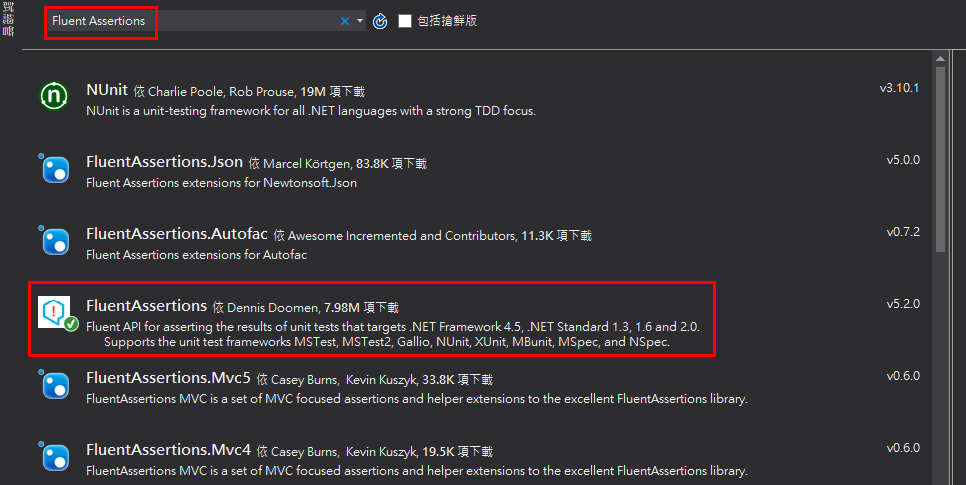FluentAssertions是很好用的套件
他讓單元測試的程式碼變的更簡潔明瞭

第一步先從Nuget安裝

如果你習慣用NUnit他也有支援、Autofac也是、這次我們只用最簡單的方式搭配VS內建的MSTest做
Fluent Assertions官方的文件寫的很清楚
我只列出我常用的部份給大家參考
using Microsoft.VisualStudio.TestTools.UnitTesting;
using FluentAssertions;
using System;
using System.Collections.Generic;
using FluentAssertions.Extensions;
using System.Linq;
namespace MySample.Controllers.Tests
{
[TestClass()]
public class HomeControllerTests
{
[TestMethod()]
public void SampleTest()
{
//文字------------------------------------------------------------
string test1 = "ABC";
test1.Should().Be("ABC");
test1.Should().NotBe("DEF");
test1.Should().BeEquivalentTo("aBc", "因為大小寫我不在意");
test1.Should().Contain("A");
test1.Should().NotContain("D");
test1.Should().ContainEquivalentOf("a", "因為大小寫我不在意");
test1.Should().NotContainEquivalentOf("d");
test1.Should().NotBeNull();
test1.Should().BeNull("因為值是 ABC 不是 null");
test1.Should().BeEmpty("因為值是 ABC 不是 空");
test1.Should().NotBeEmpty();
test1.Should().HaveLength(3);
test1.Should().BeNullOrWhiteSpace("因為值是 ABC");
test1.Should().NotBeNullOrWhiteSpace();
test1.Should().Match("*B*", "支援萬用字元");
test1.Should().MatchEquivalentOf("*b*");
//布林-----------------------------------------------------------
bool test2 = true;
test2.Should().BeTrue();
test2.Should().BeFalse("因為是 True");
//數字-----------------------------------------------------------
int test3 = 80;
test3.Should().Be(80);
test3.Should().BeInRange(0, 100, "分數只會有 0 ~ 100 分");
test3.Should().BeGreaterOrEqualTo(60, "60 分才及格");
test3.Should().BePositive("考試成績不倒扣,不會有負數");
//日期-----------------------------------------------------------
DateTime test4 = DateTime.Parse("2001/12/24 19:30");
test4.Should().BeAfter(24.December(2001));
test4.Should().Be(25.December(2001).At(19, 30), "聖誕節是12/25,不是12/24");
//集合 (最好用的地方)--------------------------------------------
List<Student> test5 = GetStudents("MyId", "John");
List<Student> test5_assert = new List<Student>
{
new Student {Id = "MyId_1", Name = "John_1" },
new Student {Id = "MyId_2", Name = "John_2" },
new Student {Id = "MyId_3", Name = "John_3" },
};
test5.Should().NotBeEmpty();
test5.Should().HaveCount(3);
test5.Should().HaveCount(q => q >= 1, "Lambda 運算式也支援");
test5.First().Should().Equals(new Student { Id = "MyId_1", Name = "John_1" });
test5.Should().BeEquivalentTo(test5_assert); //比對集合內物件的所有欄位 超強大!!!
}
/// <summary>
/// 為了方便講解
/// </summary>
private List<Student> GetStudents(string id, string name)
{
var result = new List<Student>
{
new Student {Id = id + "_1", Name = name + "_1" },
new Student {Id = id + "_2", Name = name + "_2" },
new Student {Id = id + "_3", Name = name + "_3" },
};
return result;
}
}
/// <summary>
/// 範例
/// </summary>
class Student
{
public string Id { get; set; }
public string Name { get; set; }
}
}
然後你可能會疑惑我一直在Assert後面加上一個像解釋的字串 例:"分數只會有 0 ~ 100 分" 有什麼意義?
因為如果我故意讓test case沒過 他會變成像這樣

想知道更清楚了解可以看官方文件